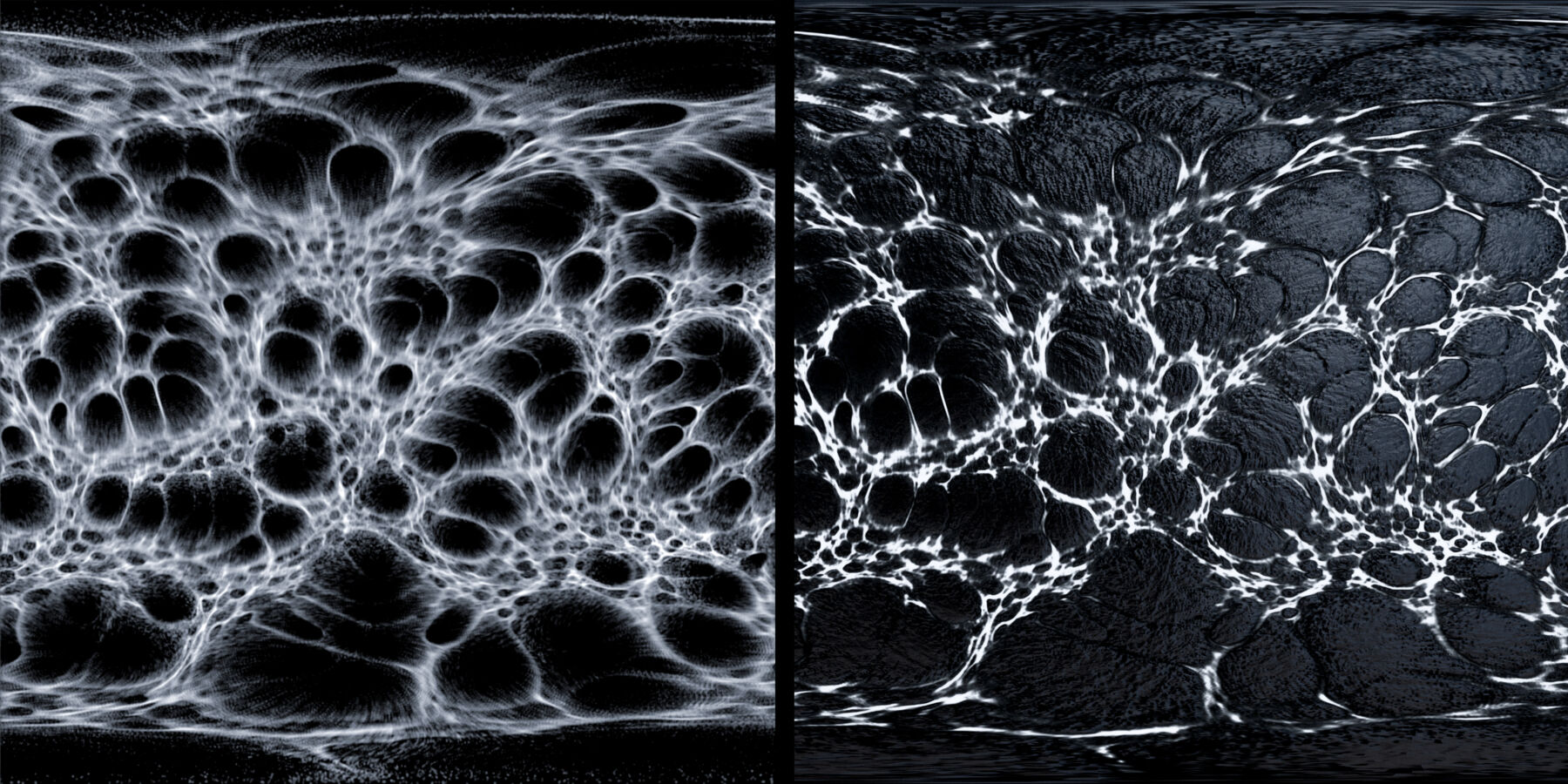Text by Olya Karlovich

Since 2007, the multidisciplinary art studio FUSE* has been exploring how new technologies and scientific discoveries can affect our perception of the outside world, reality, and ourselves. In the installations, MULTIVERSE.Dom and LUNA SOMNIUM.Dom, which will be shown at the Berlin Planetarium on June 25, the team reproduces the moment of birth and extinction of many different universes and the change of lunar phases.
The inspiration for these works was Lee Smolin’s theory (MULTIVERSE.Dom), the idea of “reproduction of universes” (fecund universes), as well as the first science fiction text, “Somnium” (the dream), by John Kepler (LUNA SOMNIUM.Dom), popularising the Copernican heliocentric system as more accurate and truthful than the geocentric theory.
The projects have been rethought and adapted to the spatial and technological capabilities of the planetarium. MULTIVERSE, which premiered in 2021, was originally a vertical projection and two flat mirror surfaces. For its new iteration, the FUSE* team has redesigned some of the 3D scenes to emphasise the “enveloping effect” of the dome. ‘To solve this aspect, we have created a system of five virtual cameras oriented in the four cardinal directions + one upwards, to obtain a vision similar to the one used in VR experiences,’ Studio Founder and Director Luca Camellini explains.
George Mavrikos, the production engineer at Zeiss-Großplanetarium who envisioned the collaboration between the Planetarium and *fuse, shares: The adaptation process for full-dome works involves collaboration among a diverse range of professionals, including artists, animators, sound designers, and technicians. Effective communication and coordination among all team members, including myself as an expert in dome projection technology, were essential in ensuring the best possible outcome for The Zeiss Gross Planetarium dome. Through our combined expertise, we aimed to provide audiences with a unique and immersive experience that aligns with the original vision of the works.
For both, MULTIVERSE.Dom and LUNA SOMNIUM.Dom, creating an immersive sound environment with third-order Ambisonic tracks was also important. In the case of Luna Somnium we already started from a circularly distributed audio, so the sound adaptation was more immediate. For Multiverse, the work took longer, moving the origin of the various sounds that make up the sound texture to envelop the viewer at 360°, Camellini comments.
He also notes that the biggest problem of presenting works in the new space was adapting the original content to ‘the resolution necessary to exploit the planetarium projection system’ capabilities. The visuals were carefully adjusted to maintain interaction and immersion from all viewing angles inside the dome.

FUSE* projects are always quite comprehensive. There is the interweaving of various mediums, the broader philosophical and poetic contexts, interaction with the audience and the ambience in them. In addition, the studio consistently works with the most advanced technological solutions. For example, in MULTIVERSE, no visual images completely repeat itself.
Every thirty minutes, through the modification of so-called “key parameters”, an “evolutionary transition” is triggered. The “creator” responsible for the birth and death of universes is the software, an application that manages the generation of the various scenes that are displayed and that interacts with Ableton Live and Max/MSP for the production of the soundtrack, According to Camellini, each generated scene “is an abstraction of some of the passages and concepts described in Smolin’s theory”.
A clear understanding of a project’s final goal is essential for FUSE* to keep the narrative coherent in the overall composition of all its elements. ‘The main question we try to keep in mind is why we are doing it, what kind of impact we want to have on people both emotionally and in terms of sharing,’ the studio founder emphasises.
‘…From a sound perspective, we wanted to convey [in MULTIVERSE] a sense of suspension and uncertainty coming from the idea that our universe and our existence are simply the results of random events and that we are a small part of something infinitely greater than ourselves. All these aspects guide us in the creative process, allowing us to make conscious choices. However, the final result remains extremely abstract to provide spaces for free interpretation to the audience, who can decide the level of depth of the project depending on their sensitivity and curiosity.’
LUNA SOMNIUM’s original version was created for Gasometro in Rome in 2022. Back then, an 18-metre, 360° projected sphere was built inside the metal structure, visible from different city places. The key idea of the project, based on Kepler’s text, has remained unchanged — our perception and vision of reality are subjective. However, in the Berlin iteration, the installation observation point has been moved from the outside to the inside — the planetarium dome plays the role of the inner surface of the moon.
From project to project, the FUSE* creative process is never completely the same. And because of non-linearity, the studio can create an experience that is unique in its immersion and depth. Generally, we start by defining a series of very general and constrained guidelines that are then refined during the process. Initially, there is a high level of variability that gradually decreases as we progress, Camellini says. He notes that during the development of any installation, his team often comes up with more interesting ideas and solutions that are not foreseen at the initial stages. Thus, the exploring theme becomes more meaningful, and the concept is stronger.
The audience also plays a significant role in FUSE* works. According to Camellini, they always strive to spark people’s curiosity and desire to explore their surroundings. ‘We like the idea that our projects can stimulate people to observe the world with more vivid eyes and make everyone feel like a part of something greater.’






